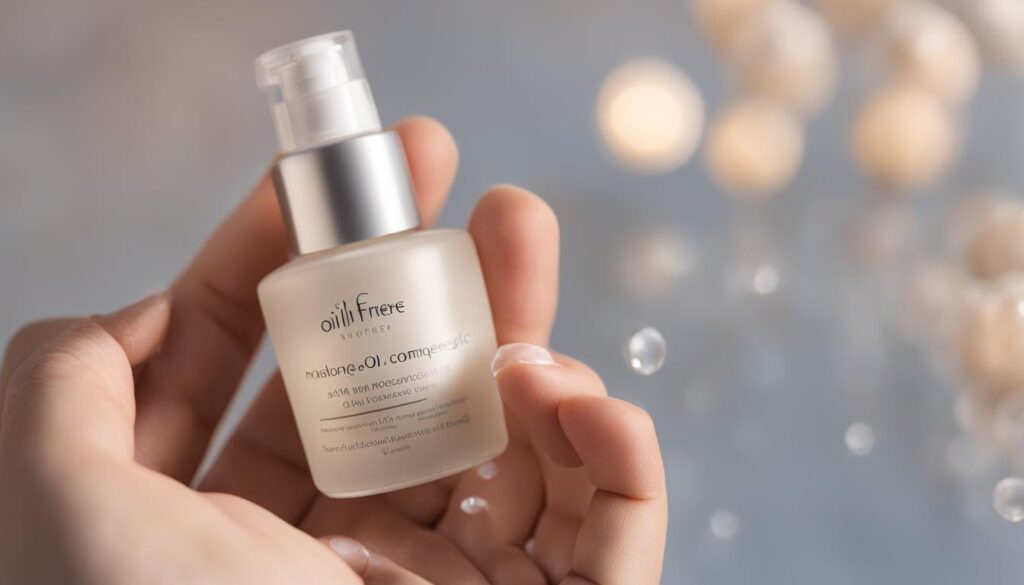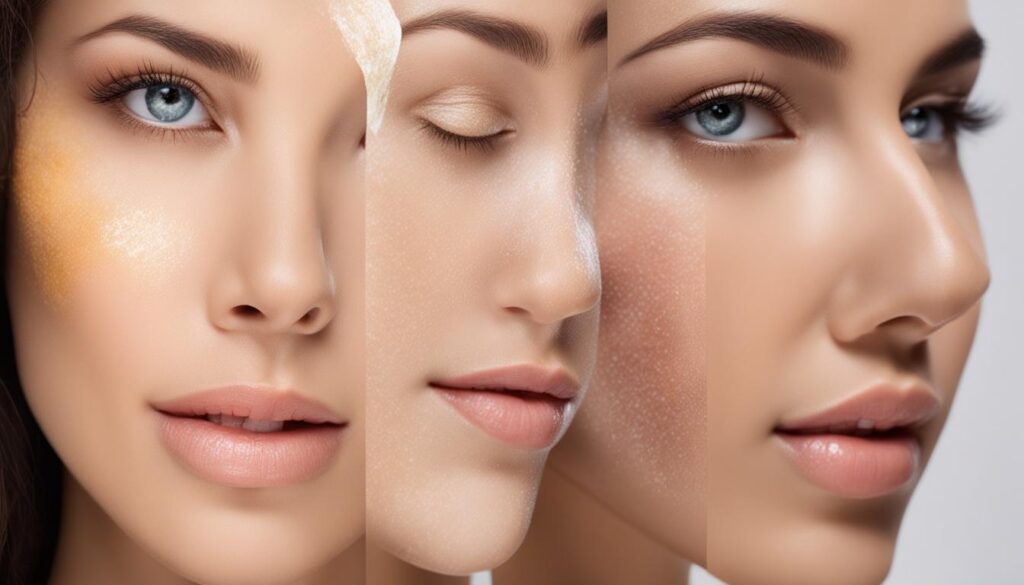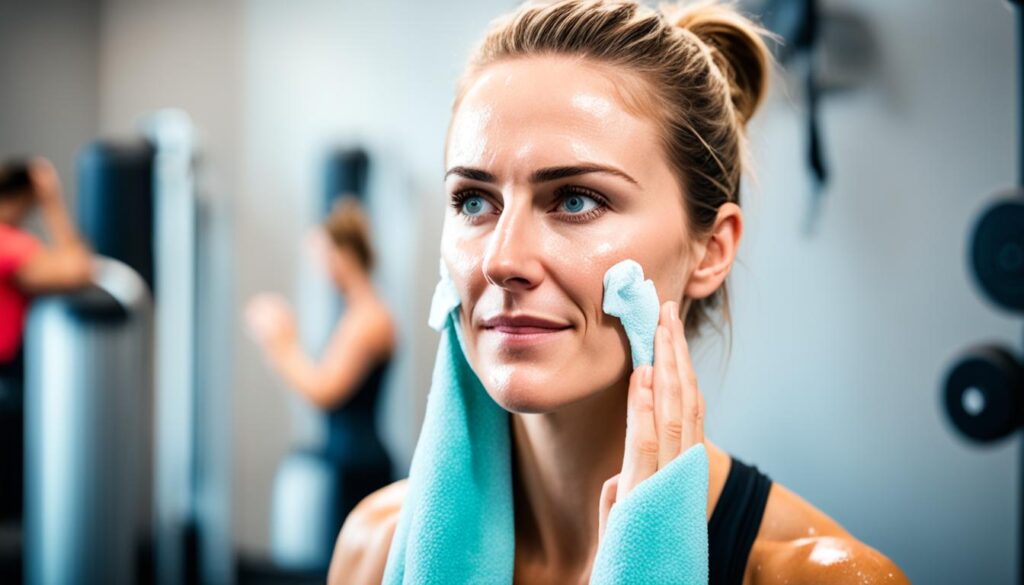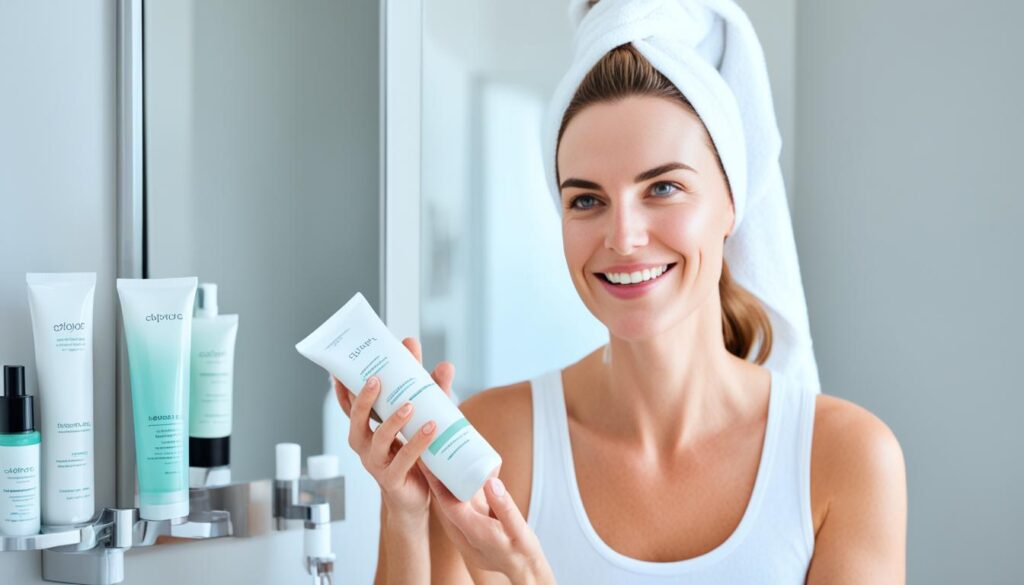Dealing with oily, acne-prone skin can be a challenge. The excess oil production often leads to frequent breakouts and a shiny, greasy complexion. However, with a proper skincare routine, you can achieve a radiant complexion and manage these concerns effectively.
In this article, I will share some valuable tips and techniques to help you take care of your oily, acne-prone skin. From cleansing and moisturizing to exfoliating and using the right products, these steps will make a noticeable difference in your skin’s appearance and overall health.
Key Takeaways:
- Regular cleansing with gentle, organic cleansers helps remove excess oil and prevent clogged pores.
- Moisturizing oily skin is essential to maintain hydration and balance oil production. Look for lightweight, water-based moisturizers.
- Using face masks with ingredients like kaolin clay, bentonite clay, sulfur, honey, and oatmeal can help control excess oil and unclog pores.
- Gentle exfoliation two to three times a week with a salicylic acid exfoliator removes dead skin cells and prevents clogged pores.
- Using a toner with ingredients like glycolic acid, lactic acid, or salicylic acid helps balance the complexion and control excess oil.
Cleanse Your Skin Regularly
Cleansing oily skin is essential for maintaining a healthy complexion. By removing excess oil and dirt, you can prevent clogged pores and reduce the risk of acne breakouts. To effectively cleanse your skin, follow these simple steps:
- Wash your face at least twice a day with warm water and a gentle soap. This will help remove impurities without stripping away essential moisture.
- Avoid using harsh cleansers that can irritate your skin and disrupt its natural balance. Instead, opt for organic cleansers specifically formulated for oily skin.
- When cleansing, use gentle circular motions to massage the cleanser into your skin. This will help stimulate blood flow and promote a healthy glow.
- After cleansing, rinse your face thoroughly with lukewarm water to remove any residue.
- Pat your skin dry with a soft towel. Avoid rubbing or scrubbing vigorously, as this can stimulate more oil production.
Remember, consistency is key when it comes to skincare. By incorporating a regular cleansing routine into your daily regimen, you can keep your skin fresh, clear, and free from excess oil.
Moisturize Your Skin
Contrary to popular belief, oily skin still needs moisturization. As someone with oily skin, I understand the struggle of finding the right moisturizer that won’t make your face feel greasy. But trust me, moisturizing is essential for maintaining a healthy complexion.

When choosing a moisturizer for oily skin, opt for lightweight formulas that won’t weigh you down. Look for water-based and oil-free options that are specifically designed to hydrate without clogging your pores.
An excellent ingredient to keep an eye out for is aloe vera, which not only helps moisturize but also has soothing properties. Look for moisturizers that contain at least 10% aloe vera to protect and hydrate your skin.
By moisturizing daily, you are not only keeping your skin hydrated but also helping to balance oil production. This balance is crucial for keeping excess oil at bay and preventing breakouts.
Apply Face Masks
Face masks are a great addition to your skincare routine, especially if you have oily, acne-prone skin. They work wonders in clearing blemishes, removing dead cells, and absorbing excess oils, leaving your skin feeling fresh and revitalized.
When choosing face masks for oily skin, look for ones that contain kaolin clay. Kaolin clay has powerful oil-absorbing properties that help control shine and reduce breakouts. It also brightens and clarifies the skin, giving you a healthy glow.
Another beneficial ingredient to look for is bentonite clay. Bentonite clay is known for its detoxifying properties, effectively removing toxins and impurities from the skin. It helps unclog pores without causing irritation, making it suitable for acne-prone skin.
If you’re dealing with stubborn breakouts, masks containing sulfur can be highly effective. Sulfur reduces oiliness, dries out existing acne, and helps prevent new breakouts. It’s a fantastic ingredient for targeting blemishes and promoting clearer skin.
For its antibacterial and absorptive properties, honey is a fantastic addition to face masks for oily skin. Honey helps soothe inflammation and nourish the skin, while its natural antibacterial properties fight acne-causing bacteria.
Last but not least, oatmeal is an excellent ingredient for oily, acne-prone skin. It acts as a gentle exfoliant, removing dead skin cells and excess oil. Oatmeal also has calming properties that help reduce redness and irritation.
When applying face masks, follow the instructions provided with the product. Typically, you’ll apply a thin, even layer to cleansed skin and leave it on for the recommended amount of time. Remember to relax and pamper yourself while the mask works its magic!
Once the mask has dried, gently rinse it off with warm water. Follow up with toner, moisturizer, and the rest of your skincare routine.
Regularly incorporating face masks into your skincare routine can make a noticeable difference in the appearance and health of your skin. Experiment with different masks and ingredients to find what works best for you. As always, it’s essential to listen to your skin and adjust your routine accordingly.
Exfoliate Frequently
Regular exfoliation is essential for maintaining the health of oily skin. By exfoliating, you can effectively remove dirt, dead cells, and excess oil that can clog pores and lead to acne breakouts. To achieve the best results, exfoliate your skin gently two to three times a week.
When exfoliating, it’s important to avoid harsh scrubbing, as this can cause irritation and stimulate more oil production. Instead, opt for a gentle exfoliator that is specially formulated for oily skin. Consider using an exfoliator that contains salicylic acid, a powerful ingredient known for its ability to penetrate the skin and eliminate acne-causing dead cells.

Salicylic acid is a beta-hydroxy acid (BHA) that acts as an exfoliant by dissolving the bonds between dead skin cells, allowing them to be easily removed. It also has anti-inflammatory properties, which can help reduce redness and calm any existing breakouts.
When using a salicylic acid exfoliator, start with a product that contains a maximum of 2% salicylic acid concentration. This will ensure effectiveness without causing irritation. Always follow the instructions on the product packaging to achieve the best results.
To exfoliate, apply a small amount of the exfoliator to clean, damp skin and gently massage it in circular motions. Pay extra attention to areas prone to oiliness, such as the T-zone (forehead, nose, and chin).
After exfoliating, rinse thoroughly with warm water and gently pat your skin dry. Follow up with a moisturizer to keep your skin hydrated.
Remember, exfoliating regularly can help enhance the effectiveness of your skincare routine and improve the overall appearance of your oily skin. However, if you have sensitive skin or any skin conditions, it’s always best to consult with a dermatologist before incorporating new exfoliation products into your routine.
Use a Toner
Toning is a crucial step in my oily skincare routine. It helps clear my pores, balance my complexion, and remove excess oils. When choosing a toner, I always look for ones that contain key ingredients like glycolic acid, lactic acid, and salicylic acid. These ingredients not only help restore the pH level of my skin but also improve my skin tone.
One of my go-to toners is the XYZ Toner with Glycolic Acid. This toner not only helps control excess oil but also exfoliates my skin, leaving it looking refreshed and glowing. I apply the toner to a cotton pad and gently swipe it across my face and neck, focusing on areas prone to oiliness.
Another great option for oily skin is the ABC Lactic Acid Toner. Lactic acid helps exfoliate dead skin cells and improve the overall texture of my skin. I find that using this toner regularly keeps my skin looking smooth and minimizes the appearance of pores.
I also love incorporating a salicylic acid toner, like the DEF Salicylic Acid Toner, into my routine. Salicylic acid is excellent for combating acne and controlling oil production. This toner helps keep my skin clear and reduces the occurrence of breakouts.
Keep in mind that everyone’s skin is unique, so it’s essential to find a toner that works well for you. I recommend starting with a lower concentration of acids and gradually increasing it if your skin tolerates it well. Apply toner at least twice a day, but be cautious not to overuse it, especially if your skin tends to get irritated easily.
Face Washing After Exercising
After a vigorous workout session, it is essential to cleanse your face to maintain clear and healthy skin. Exercising leads to sweating, which can clog pores and contribute to acne breakouts. To prevent these issues, make sure to follow a post-workout skincare routine that includes cleansing and moisturizing.
Start by using a gentle cleanser that suits your skin type. Look for a cleanser specifically designed for post-workout use or one that targets acne-prone skin. Massage the cleanser onto your damp face, paying extra attention to areas where sweat tends to accumulate, such as the forehead, nose, and chin. Rinse thoroughly with lukewarm water to remove all traces of sweat, dirt, and bacteria.
Once you’ve cleansed your face, pat it dry with a clean towel or use blotting papers to absorb excess sweat and oil. Avoid rubbing your skin vigorously, as it can irritate and worsen acne-prone areas.

After cleansing, don’t forget to moisturize your skin. Even if you have oily skin, it’s essential to provide hydration to keep your skin balanced and prevent excessive oil production. Choose a lightweight, oil-free moisturizer that won’t clog your pores.
By incorporating face washing into your post-workout routine, you can effectively cleanse away sweat, dirt, and bacteria, reducing the likelihood of acne breakouts. It’s an important step in maintaining healthy, blemish-free skin.
Blotting Papers for Oil Control
When it comes to managing oily skin, blotting papers are a game-changer. These pocket-sized papers are a handy tool to have on hand throughout the day to combat excess oil and maintain a shine-free complexion.
To use blotting papers effectively, simply press a sheet gently against your skin, focusing on areas prone to oiliness such as the T-zone. The paper will absorb excess sebum without disturbing your makeup, leaving your skin looking fresh and matte.
Blotting papers are designed to remove the excess oil that can accumulate on your skin’s surface throughout the day. By removing this excess oil, you can help prevent clogged pores and minimize the risk of acne breakouts. It’s a quick and convenient way to keep your skin looking and feeling its best.
For optimal results, I recommend keeping blotting papers in your bag or desk drawer so you can reach for them whenever you need a quick touch-up. Repeat the process as needed throughout the day to keep your pores clean and maintain a shine-free complexion.
Conclusion
In summary, maintaining a consistent skincare routine is essential for effectively managing oily acne-prone skin. By following these simple yet effective tips, you can achieve a balanced and clear complexion. Firstly, make sure to cleanse your skin regularly with a gentle soap or organic cleanser to remove excess oil and prevent clogged pores. Remember to moisturize your skin with a lightweight, water-based moisturizer to keep it hydrated without adding extra oils.
Additionally, incorporating face masks into your skincare routine can help remove dead cells, absorb excess oils, and unclog pores. Look for masks with natural ingredients like kaolin clay, bentonite clay, sulfur, honey, and oatmeal for their clarifying and antibacterial properties. Don’t forget to exfoliate your skin frequently to eliminate dirt and dead cells, using an exfoliator with salicylic acid for maximum effectiveness.
Using a toner in your daily regimen can also make a significant difference in managing oily skin. Opt for a toner containing glycolic acid, lactic acid, or salicylic acid to help balance your skin’s pH, clear pores, and control excess oil production. Lastly, protect your skin from the sun by applying sunscreen every day, as sun exposure can aggravate acne and uneven skin tone.
While these tips can certainly improve your skin’s condition, consulting with a dermatologist for personalized recommendations and treatments can help address specific skin concerns more effectively. Remember, achieving healthy, radiant skin requires a holistic approach and a combination of both proper skincare and professional guidance.
FAQ
How often should I cleanse my oily acne-prone skin?
It is recommended to cleanse your face at least twice a day with warm water and a gentle soap. Avoid using harsh cleansers and opt for organic options.
Do I need to moisturize my oily skin?
Yes, even oily skin needs moisturization. Choose a moisturizer with at least 10% aloe vera and opt for water-based, oil-free, and lightweight options.
What ingredients should I look for in face masks for oily acne-prone skin?
Look for masks with ingredients like kaolin clay, bentonite clay, sulfur, honey, and oatmeal. These ingredients help remove dead cells, absorb excess oils, and unclog pores.
How often should I exfoliate my oily skin?
Exfoliate gently two to three times a week with an exfoliator that contains a maximum of 2% salicylic acid. This will help remove dirt and dead cells and prevent clogged pores.
Why is toning important for oily skin?
Toning helps clear pores, balance complexion, and remove excess oils. Look for toners with ingredients like glycolic acid, lactic acid, and salicylic acid to restore the pH level of your skin and improve your skin tone.
Should I cleanse my face after exercising?
Yes, it is recommended to cleanse your face after exercising to remove sweat and dirt that can clog pores and lead to acne breakouts. Use your regular cleanser and moisturizer to keep your pores clean.
How can I control excess oil throughout the day?
Blotting papers are a handy tool to absorb sebum and keep your pores clean. Gently press a blotting paper against your skin as needed to maintain a shine-free complexion.
What’s the importance of having a consistent skincare routine for oily acne-prone skin?
Having a consistent skincare routine is crucial for managing oily acne-prone skin. Remember to cleanse, moisturize, and exfoliate regularly. Use masks, toners, and blotting papers to control excess oil and protect your skin from the sun by applying sunscreen daily.
Should I consult a dermatologist for my oily acne-prone skin?
Yes, it is advisable to consult with a dermatologist for personalized recommendations and treatments to address specific skin concerns.

